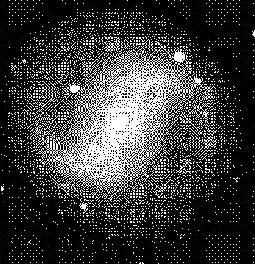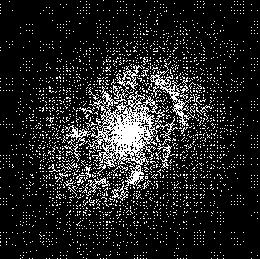


4.5. Decoupling of a nuclear disk
The bar torques drive progressively more mass towards the center.
This matter, gaseous at the beginning, forms stars, and
gradually contributes to the formation of the bulge, since
stars are elevated above the disk plane, through vertical
resonances with the bar (e.g.
Combes et al. 1990,
Raha et al. 1991).
When the mass accumulation is large enough,
then the precessing rate
 -
-
 / 2 curve
is increasing strongly while the radius decreases, and
this implies the formation of two inner Lindblad resonances.
In between the two ILRs, the periodic orbits are
perpendicular to the bar (x2 orbits), and the bar
loses its main supporters. The weakening of the
primary bar, and the fact that the frequencies of
the matter are considerably different now between the
inner and outer disk,
forces the decoupling of a nuclear disk, or nuclear bar from
the large-scale bar (primary bar).
/ 2 curve
is increasing strongly while the radius decreases, and
this implies the formation of two inner Lindblad resonances.
In between the two ILRs, the periodic orbits are
perpendicular to the bar (x2 orbits), and the bar
loses its main supporters. The weakening of the
primary bar, and the fact that the frequencies of
the matter are considerably different now between the
inner and outer disk,
forces the decoupling of a nuclear disk, or nuclear bar from
the large-scale bar (primary bar).
Nuclear disks are frequently observed, at many wavelengths: optical with the HST (e.g. Barth et al 1995, or fig 10) or in CO molecules with millimeter interferometers (Ishizuki et al 1990). A recent survey in the Virgo cluster (Rubin et al 1997) reveals that about 20% of the 80 spirals observed possess a decoupled nuclear disk. In nearly edge-on systems, these nuclear disks are conspicuous through large velocity gradients, like in the Milky-Way (Dame et al 1987) or NGC 891 (Garcia-Burillo & Guélin 1995).

|

|
Figure 10. Photographs of the barred galaxy NGC 4314. (top) A general view of the bar and the spiral arms (photo from McDonald Observatory, Texas). (bottom) A zoom on the central parts (corresp. to the square in the first picture), with the Hubble Space Telescope. A nuclear ring can be discerned, within which a second independent spiral structure has developed (from Benedict et al. (1996).) |